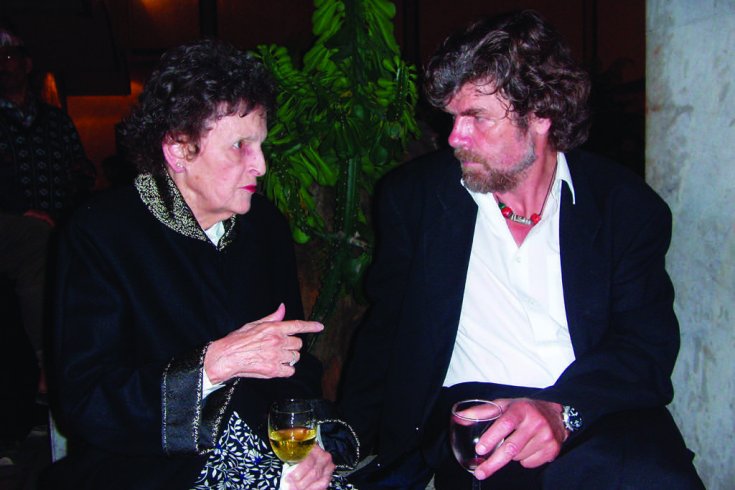
kathmandu — Whether you’re Reinhold Messner, who completed his solo climb in 1980, or part of a modern expedition packing sushi, anyone who makes it to the top of Mount Everest faces one more challenge: a question- and-answer session with Elizabeth Hawley, at the age of eighty-two still the authoritative chronicler of climbing in the Himalayas.
Hawley is the first person to interview exhausted climbers when they get back to Kathmandu. She grills them with detailed questions about the route: What did you see from the summit? Where were the prayer flags? How many peaks were visible? If their answers satisfy her, the expedition becomes part of the mountaineering history represented in her huge archives.
The irony is that Hawley, a journalist who began her career in the 1940s as a researcher for Fortune magazine in New York, doesn’t climb herself. She has never been to Everest’s base camp, let alone above 8,000 metres — the altitude threshold that attracts so many “peak-baggers” to the Himalayas. But in the more than four decades that she has spent living and working in the Nepalese capital, witnessing the rise and fall of royal dynasties and the advent of democracy, Hawley has come to know the physical face of these mountains as intimately as anyone.
If a lone climber comes back down claiming that he summited on Shishapangma when in fact he burrowed into his tent and wrote postcards instead, no one is going to challenge him — except, perhaps, for Hawley. She was not impressed, for instance, by Yuichiro Miura’s 1970 venture, documented in the popular film The Man Who Skied Down Everest. “He didn’t ski down Everest,” Hawley says. “He didn’t start at the top and he damned near killed himself skidding to a lucky halt.”
Messner, on the other hand, is a climber whose achievements she unreservedly admires. He accomplished his historic climb of the world’s highest peak alone in just three days; for his summit bid, he carried only a camera and an ice axe. Now that professional guides can call on an army of Sherpas, a web of fixed ropes, and high-tech gear to comfortably hoist clients up the mountain regardless of their condition, Messner’s doctrine of climbing by “fair means” — no oxygen bottles, limited ropes, few camps, minimal support teams — represents the golden age of Himalayan mountaineering, an era in which Hawley played a vital role.
Since Edmund Hillary — a long-time friend of Hawley’s — and Tenzing Norgay made the first successful ascent in 1953, tackling Everest has become a crowded and increasingly corporate industry. Last year there were 102 registered climbs on the mountain. “There are way too many expeditions these days,” complains Hawley, who now requires two assistants to cover them all.
The competitive conditions created by so many climbers trying to get to the top have given rise to controversy on the mountain. Earlier this year, several expedition members at high altitude on Everest passed David Sharp, an ailing climber, without helping him. When Sharp died, the media was quick to pounce. Hillary himself said that leaving a colleague to die alone is not in the spirit of climbing.
Hawley’s response was precise and blunt, and offered a different view. “Much of the outraged commentary about people callously passing David Sharp high on Everest is unwarranted,” she says. “He insisted on climbing alone, which is unwise unless you are one of the world’s best mountaineers. He climbed alone and tragically died alone.”
In fact, the Himalayas are littered with the bodies of climbers who have perished. And the gruesome truth is that they must remain there: recovering bodies from such high altitudes is simply too difficult and dangerous. George Mallory’s corpse, lost since he died on Everest in 1924, was discovered only in 1999 by American mountaineer Conrad Anker. Serious mountaineers in the Himalayas are braced for the disturbing dioramas of long-dead climbers, frozen in time, who didn’t make it.
“Some people on their way to or from the summit did stop and try to help David Sharp,” Hawley says. “But to expect people to effect a complete rescue operation at that altitude when they themselves are nearly exhausted and running low on oxygen is unrealistic.” Moreover, even alert climbers might be forgiven for failing to have seen him in the first place. “Many who passed him had no idea he was there, in a shallow cave, and not easy to spot,” she adds. “It was a dark night, and headlamps focus on restricted areas. Then after dawn, the day was very cold, so they would still have had their hoods around their faces.” A final, chilling reason: “He was lying on the body of a long-dead Indian” — a known, sombre landmark on the mountain — “and some probably assumed he was that Indian. Armchair critics fail to take all these factors into account.”
Of course, Elizabeth Hawley could herself be described as an armchair critic, albeit a deeply informed and exacting one. But she has planted her own flag in the Himalayan mountains. As Russian climber Anatoli Boukreev said after Hawley challenged his claim to have reached the highest summit of Shishapangma, “I’ve got to go back — Elizabeth said I didn’t really climb it.”



